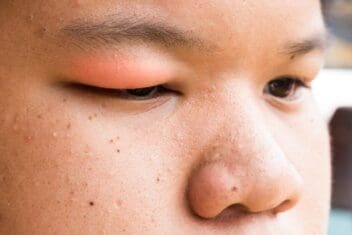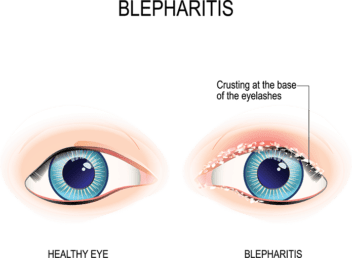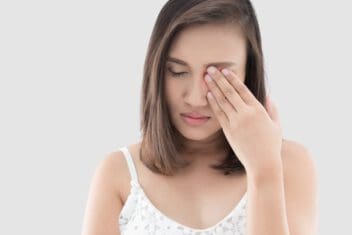
Medically Reviewed by Tom Tooma, M.D., Founder/Medical Director NVISION Surgeon
Swollen Eyelids? Causes & How to Fix Them (Fast)
Home / Eye Health and Preventive Care /
Last Updated:

Medically Reviewed by Tom Tooma, M.D., Founder/Medical Director NVISION Surgeon

Article At a Glance
Swollen eyelids can result from various causes, including allergies, infections, blocked oil glands, and underlying health conditions. While minor swelling may resolve with home remedies like warm compresses, persistent or severe cases could indicate serious issues such as cellulitis or thyroid disorders. Timely medical evaluation is essential to determine the cause and appropriate treatment.
Swollen eyelids are a common symptom experienced by almost everyone at some point or another. Our eyelids, along with eyelashes and even eyebrows, are there to protect the sensitive eyeball. Therefore, it is inevitable that eyelids might become irritated, since they’re a first-line defense from eye injury and trauma.
The causes can be anything from trivial irritants and temporary conditions to serious conditions that require treatment. Here, we explore a full course of possible causes and remedies to eyelid swelling.
Table of Contents
Swollen eyelids can happen for a wide range of possible causes, ranging from temporary irritants to infections that may require medical attention. They may also be a symptom of allergies or chronic conditions that might require ongoing medical oversight and treatment.
Eye health is closely associated with general health of the whole body, so sometimes the eyes are truly a window to an underlying medical issue.
Symptoms Associated With Swollen Eyelids
Understanding the causes of swollen eyelids starts with an accurate diagnosis. Eyelid swelling can be an irritating problem, and if you experience these symptoms frequently, you might have other issues that you need to look into.
Symptoms associated with swollen eyelids include:
You deserve clear vision. We can help.
With 135+ locations and over 2.5 million procedures performed, our board-certified eye surgeons deliver results you can trust.
Your journey to better vision starts here.
- Edema – This is the presence of inflamed skin tissue or excessive fluid around the connective tissues surrounding the eye. Severe edema calls for a doctor’s visit.
- Itchy and scratchy sensation – Rubbing or scratching them may just irritate them further.
- Sensitivity to light – A chronic condition for some, or a sign of a severe problem if it crops up suddenly.
- Watery eyes – Your eyes make too much moisture, even releasing tears, but not accompanying a normal crying spell.
- Redness in the eye whites – Also known as “bloodshot eyes.”
- Obstructed vision – Your eyelids might swell enough that you’re forced to squint.
- Redness on the skin of the eyelid – A sign of irritation or inflammation.
- Discharge – Any discharge coming from the eye, such as pus, is sign of a serious infection that requires medical attention.
- Pain or heat sensations – Eye pain often presents as a migraine or headache. Warm feeling, such as a fever, but only around the eyes, is another sign of infection.
In cases where swollen eyelids are a sign of infection, this may be a condition which you should take seriously. If your swollen eyelids are accompanied by discharge, redness, heat, pain, or problems with vision, seek medical help immediately. Leaving an eye infection to fester for an extended period of time risks permanent damage to the eyes.

Most Common Causes of Swollen Eyelids

The treatment options for swollen eyelids depend on the root cause of the swelling. The causes can range from common irritants to rare medical conditions, which we will also explore.
- Contact allergy – This is when a particle of dust, pollen, or pet dander gets into your eye. Even if you don’t typically have allergic reactions, your eye is naturally defensive about any foreign substance or object. In some cases of contact allergy, the swelling will go away on its own. Chronic allergy sufferers may reach for an antihistamine, which reduces inflammation and swelling all over, including the eyes.
- Widespread allergy – This is the case for chronic allergy sufferers. If you have frequent experience with an allergic reaction to plants, pollen, animals, or foods, swollen eyelids can present as a symptom. An antihistamine or anti-inflammatory medication can help reduce symptoms. In the case of enduring, severe allergies, consulting with a doctor might be necessary to manage the condition.
- Eye irritants – This includes occasions like getting make-up in your eye, handling spicy foods such as onions or peppers and getting some oil in your eye, or being exposed to thick smoke or fumes from industrial chemicals. A possible treatment for this situation might be using water or eye drops to wash out the eye.
- Blepharitis – This may be an infection of the tissues around the eye, or it could be associated with the herpes simplex virus. Along with eyelid swelling, you may notice yellow crust along the eyelashes, itching or burning eyes, redness, and sores. This typically affects both eyes at the same time. A doctor’s examination can determine if blepharitis is causing your symptoms.
- Chalazion – This is the enlargement of an oil gland inside your eyelid, and it typically affects only one eye at a time. You will develop an enlarged, red, sore area that will look like a small mound. Pain will go away first, followed by decreased swelling. A doctor’s examination is required for treatment for a chalazion because it will not go away on its own.
- Conjunctivitis – More commonly known as pink eye, this is an infection characterized by redness, discharge, and sometimes crust on the eyelashes. It can affect one or both eyes, and it may look like an allergic reaction at first. Symptoms will get worse, not better, so see a doctor for medicated eye drops and stop wearing your contact lenses immediately.
- Stye – The medical term for a stye is hordeolum, and this typically is a red, inflamed, painful area in one eyelid. Eventually, the swelling will even out, sometimes with small, raised, pus-filled bumps. Visit a doctor for treatment recommendations if it doesn’t clear in a couple of days.
- Orbital cellulitis – Tissue infection in or around the eye socket can present as eyelid swelling. This will be accompanied by redness, pain in the eyeball, and bulging eyes. It will start in one eye and spread to the other.
- Preseptal/periorbital cellulitis – Like orbital cellulitis, this is an infection of skin tissue, but it occurs around the outside of the eye rather than the interior tissues. This may be accompanied by pain and fever.
- Insect bite – Itching, redness, and a small bump suggest you may have been bitten by a bug or insect, but a doctor will be able to accurately distinguish between an insect bite and other potential causes of eyelid swelling. Mosquitoes and some other blood-sucking pests tend to go for thin, tender skin such as eyelids.
Eye Swelling Scale
Once we have determined that we have a case of swollen eyelids, the next step is to rate the severity of the swelling.
- Mild: You can see as normal and it’s only slightly irritating, but the eyes still function normally and aren’t accompanied by discharge, pain, or heat.
- Moderate: You can still open your eyes for the most part, but the swelling is more pronounced. Other people can notice it.
- Severe: You can’t open your eyes all the way, with the eyelids swollen almost or completely shut.
In the cases from mild to moderate, chances are that you’ll be able to treat the condition at home. If the case is moderate to severe, you will likely require medical attention.
Differences Between Puffy and Swollen Eyelids

Puffy eyes are a different matter form eyelid swelling. Puffiness around the eyes just presents as a general enlargement of the tissue around your eyes, without any other symptom. In the case of puffy eyes, a simple home treatment can usually resolve the matter.
Causes of puffy eyes or eyelids may include any of the following:
- Too much salt in your diet, leading to fluid retention
- Allergies that can lead to inflammation
- Cosmetic products irritating the eye
- Sinus issues or sinus infection
- Dehydration
- Lack of sleep or waking abruptly from sound sleep
- Stress
- Crying
- Genetic factors
- Aging
Puffiness of the eye tissue typically goes away on its own, or with simple home remedies. Swollen eyelids, however, may represent a more serious issue or require some treatment to remedy.
Less Common Medical Conditions Associated With Swollen Eyelids
In addition to problems in the eye area itself, there are a number of general health conditions which can have swollen eyelids as a symptom. If you have other symptoms or risk for any of these conditions, you might be better off seeking a general practitioner rather than an eye doctor.
- Shingles – This is the same virus that causes chicken pox, which lies dormant after the initial infection but may become active again in adulthood. The most common symptoms are skin rash and pain, particularly along the sides or flanks of the body. In rare cases, you may develop a rash around the face, which can cause swelling in or around your eyelids.
- Hypothyroidism – An underactive thyroid gland mostly causes fatigue and weight changes, but puffy or swollen eyes may be one of several symptoms that your body is not managing hormone production. This requires a doctor’s diagnosis to begin treatment.
- Graves’ disease – The opposite of hypothyroidism, this condition involves an overactive thyroid gland caused by an immune problem. Bulging eyes, double vision, anxiety, weight loss, and rapid heartbeat are all symptoms of Graves’ disease, which can only be diagnosed by a medical professional.
- Systemic disorders (preeclampsia, kidney disease, cardiovascular disease, and liver failure) – Edema, or fluid retention, is a symptom of many diseases that affect the whole body. The eyes are one of several areas where you may notice unusual swelling.
You deserve clear vision. We can help.
With 135+ locations and over 2.5 million procedures performed, our board-certified eye surgeons deliver results you can trust.
Your journey to better vision starts here.
Prevention for Eyelid Swelling
If you frequently experience swollen eyelids, observing some precautionary measures may help lead to fewer incidents.
- Keep your hands clean – We tend to rub our eyes at odd moments without even realizing what we’re doing. Washing your hands often helps prevent irritants or allergens from making contact with your eyes. A special “gotcha” for the culinarily inclined: Be vigilant in washing your hands after cutting foods such as peppers, onions, garlic, ginger, or horseradish. Rubbing your eye with jalapeno oil on your finger is a mistake every chef commits once!
- Keep your face clean – The next most common contact area for irritants to the eye is the face itself. Never go to bed with make-up on.
- Wear eye protection – If you’re working with harsh chemicals, sawdust, plants, insulation, or any other number of hazards, wearing protective eye gear is a prudent precaution.
- Avoid touching your eyes – No matter how clean we are, microscopic matter can still get into the eye when we make hand contact. If you feel like wiping or rubbing your eyes, perhaps try using a sterile cloth or tissue.
- Avoid irritants and allergens – When in doubt, choose products that don’t have a heavy fragrance or which state that they are made for “sensitive skin.”
Treatments for Eye Swelling
In cases where the swelling isn’t serious or known to have a temporary cause, such as allergies, some of these simple home remedies can work wonders.
- Apply a cold compress – As with any inflammation, a cold pack across your eyes can help reduce swelling and provide relief from pain and irritation.
- Elevating the head – Lying down flat on your back can cause blood to rush to your head, worsening the swelling. Try lying with pillows stacked to prop up your head.
- Gentle cleaning – Using water to rinse the eyelids gently.
- Using saline solution – Eyewash solutions are available over the counter and are specifically formulated not to irritate sensitive eye tissue.
- Anti-inflammatory medications – Any over-the-counter treatment which reduces inflammation and is gentle enough to use around your eyes.
Tea Bags and Cucumber Slices
We’ve all seen the spa treatment where people place tea bags over their eyes and rest for a while. Does this really help? Yes, there is some science behind the teabag treatment!
Tea contains caffeine, which, even when applied topically, shrinks blood vessels and helps reduce swelling. In addition, different kinds of tea may have additional benefits due to their essential oils and compounds.
To use the teabag trick, make tea just as you normally would with hot water and letting the teabags steep. Afterwards, remove the teabags and squeeze out the excess water – squeezing between two spoons helps spare getting your hands messy. Let the bags cool for a few minutes, then lay back and gently place the teabags over your closed eyes for fifteen to thirty minutes.
Another common remedy is to use cucumber slices over the eyes. There is science to this as well; cucumbers have antioxidant properties and are usually high in moisture, providing natural cooling and some essential oil ingredients at one go. Cucumber extract is even used in some cosmetics for the same reason.
To use cucumber slices, start with a fresh, refrigerated cucumber – not packed in vinegar in a jar! Slice a couple slices about a centimeter thick, then recline and place them on your closed eyelids for about fifteen to thirty minutes.
Cucumber eye creams are also made for this same purpose, if you don’t usually have fresh produce lying around.
In Conclusion
Swollen eyelids may have a trivial cause which you can remedy at home, or might have a more severe cause or underlying condition that should be taken to a medical professional. Treatments for swollen eyelids can not only help you feel better, but can be good for your looks too. Occasional issues with swollen eyelids happen to almost everyone, but persistent or chronic conditions can be a sign of urgent medical issues.
As always, consult with a medical professional if you have any concerns that are not covered here.
You deserve clear vision. We can help.
With 135+ locations and over 2.5 million procedures performed, our board-certified eye surgeons deliver results you can trust.
Your journey to better vision starts here.
References
- Some Causes and Features of Eyelid Swelling. Merck Manual, Consumer Version.
- Cucumbers On The Eyes: Do They Do Anything? (May 2022) Skin Elite
- Puffy Eyes: What Causes Them and What to Do About It. (April 2019). Cleveland Clinic.
- 8 Reasons Why Your Eyes Are So Puffy—And What To Do About It, According to A Dermatologist. (April 2020). Women’s Health.
- Top Causes of Swollen Eyelids. (December 1, 2018). Verywell Health.
- Here’s the Tea: Use Tea Bags on Your Eyes. Greatist.

Dr. Tooma, the founder of NVISION® Eye Centers, has performed well over 130,000 LASIK surgeries, making him the most experienced LASIK surgeon in the Western United States.
This content is for informational purposes only. It may have been reviewed by a licensed physician, but is not intended to serve as a substitute for professional medical advice. Always consult your healthcare provider with any health concerns. For more, read our Privacy Policy and Editorial Policy.
